CHEVROLET VOLT 2012 1.G Owners Manual
Manufacturer: CHEVROLET, Model Year: 2012, Model line: VOLT, Model: CHEVROLET VOLT 2012 1.GPages: 454, PDF Size: 7.89 MB
Page 291 of 454
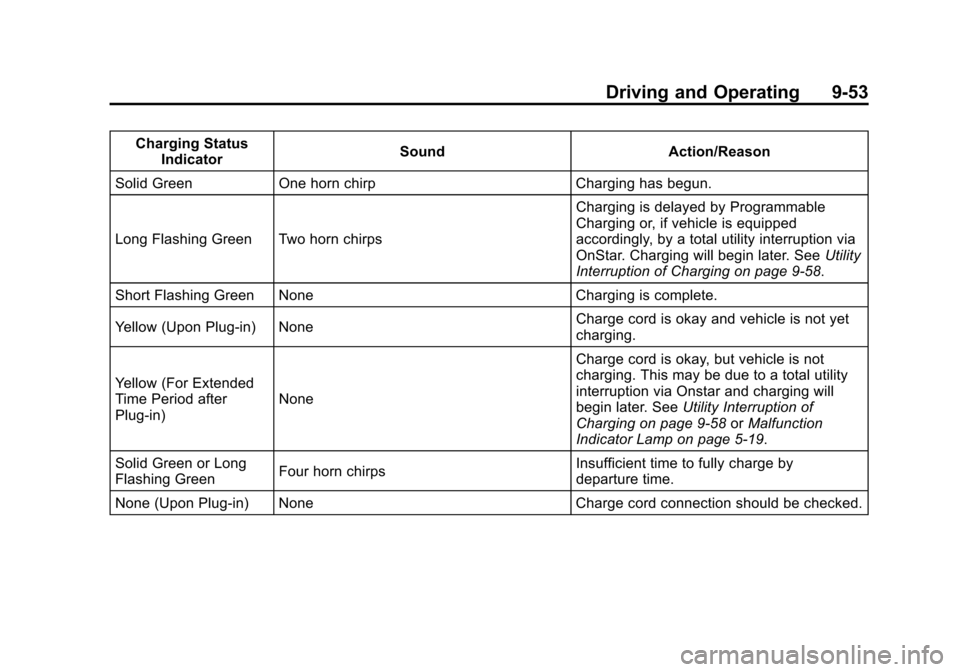
Black plate (53,1)Chevrolet Volt Owner Manual - 2012
Driving and Operating 9-53
Charging StatusIndicator Sound Action/Reason
Solid Green One horn chirp Charging has begun.
Long Flashing Green Two horn chirps Charging is delayed by Programmable
Charging or, if vehicle is equipped
accordingly, by a total utility interruption via
OnStar. Charging will begin later. See
Utility
Interruption of Charging on page 9‑58.
Short Flashing Green None Charging is complete.
Yellow (Upon Plug‐in) None Charge cord is okay and vehicle is not yet
charging.
Yellow (For Extended
Time Period after
Plug‐in) None Charge cord is okay, but vehicle is not
charging. This may be due to a total utility
interruption via Onstar and charging will
begin later. See
Utility Interruption of
Charging on page 9‑58 orMalfunction
Indicator Lamp on page 5‑19.
Solid Green or Long
Flashing Green Four horn chirps Insufficient time to fully charge by
departure time.
None (Upon Plug‐in) None Charge cord connection should be checked.
Page 292 of 454
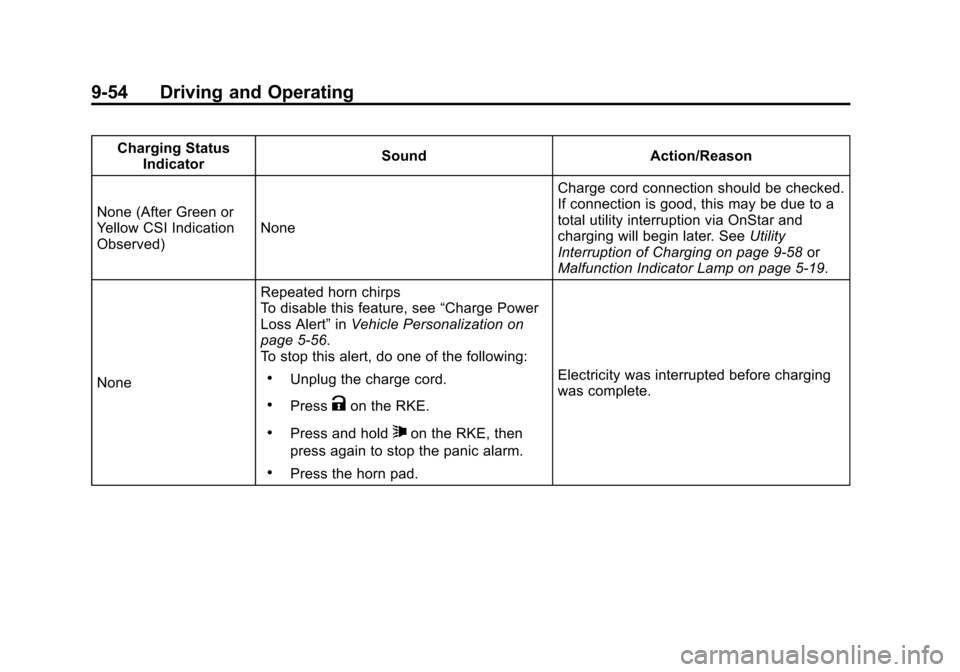
Black plate (54,1)Chevrolet Volt Owner Manual - 2012
9-54 Driving and Operating
Charging StatusIndicator Sound Action/Reason
None (After Green or
Yellow CSI Indication
Observed) None Charge cord connection should be checked.
If connection is good, this may be due to a
total utility interruption via OnStar and
charging will begin later. See
Utility
Interruption of Charging on page 9‑58 or
Malfunction Indicator Lamp on page 5‑19.
None Repeated horn chirps
To disable this feature, see
“Charge Power
Loss Alert” inVehicle Personalization on
page 5‑56.
To stop this alert, do one of the following:
.Unplug the charge cord.
.PressKon the RKE.
.Press and hold7on the RKE, then
press again to stop the panic alarm.
.Press the horn pad. Electricity was interrupted before charging
was complete.
Page 293 of 454
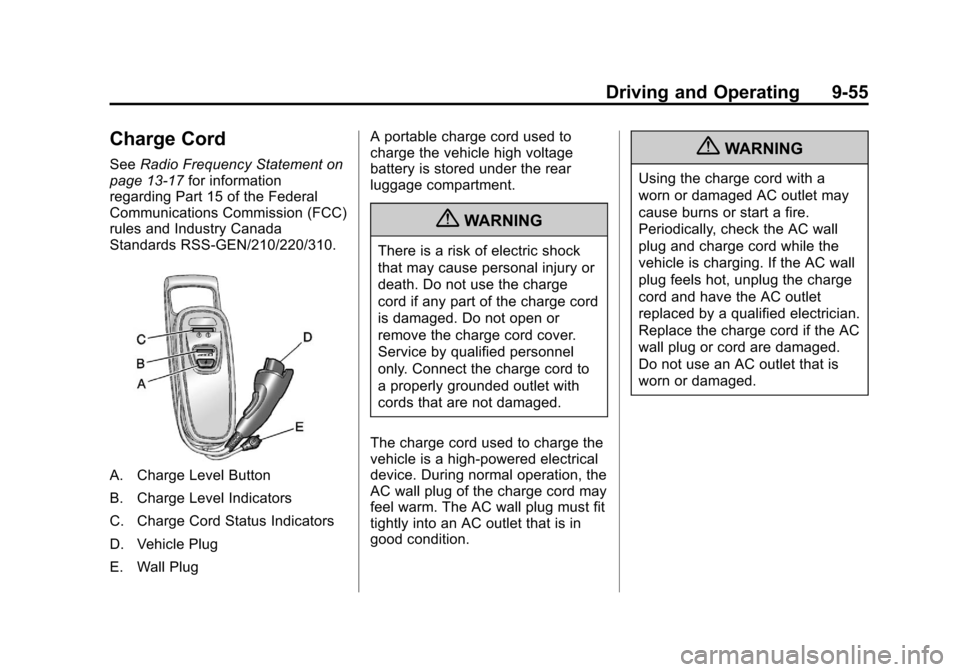
Black plate (55,1)Chevrolet Volt Owner Manual - 2012
Driving and Operating 9-55
Charge Cord
SeeRadio Frequency Statement on
page 13‑17 for information
regarding Part 15 of the Federal
Communications Commission (FCC)
rules and Industry Canada
Standards RSS-GEN/210/220/310.
A. Charge Level Button
B. Charge Level Indicators
C. Charge Cord Status Indicators
D. Vehicle Plug
E. Wall Plug A portable charge cord used to
charge the vehicle high voltage
battery is stored under the rear
luggage compartment.
{WARNING
There is a risk of electric shock
that may cause personal injury or
death. Do not use the charge
cord if any part of the charge cord
is damaged. Do not open or
remove the charge cord cover.
Service by qualified personnel
only. Connect the charge cord to
a properly grounded outlet with
cords that are not damaged.
The charge cord used to charge the
vehicle is a high‐powered electrical
device. During normal operation, the
AC wall plug of the charge cord may
feel warm. The AC wall plug must fit
tightly into an AC outlet that is in
good condition.
{WARNING
Using the charge cord with a
worn or damaged AC outlet may
cause burns or start a fire.
Periodically, check the AC wall
plug and charge cord while the
vehicle is charging. If the AC wall
plug feels hot, unplug the charge
cord and have the AC outlet
replaced by a qualified electrician.
Replace the charge cord if the AC
wall plug or cord are damaged.
Do not use an AC outlet that is
worn or damaged.
Page 294 of 454
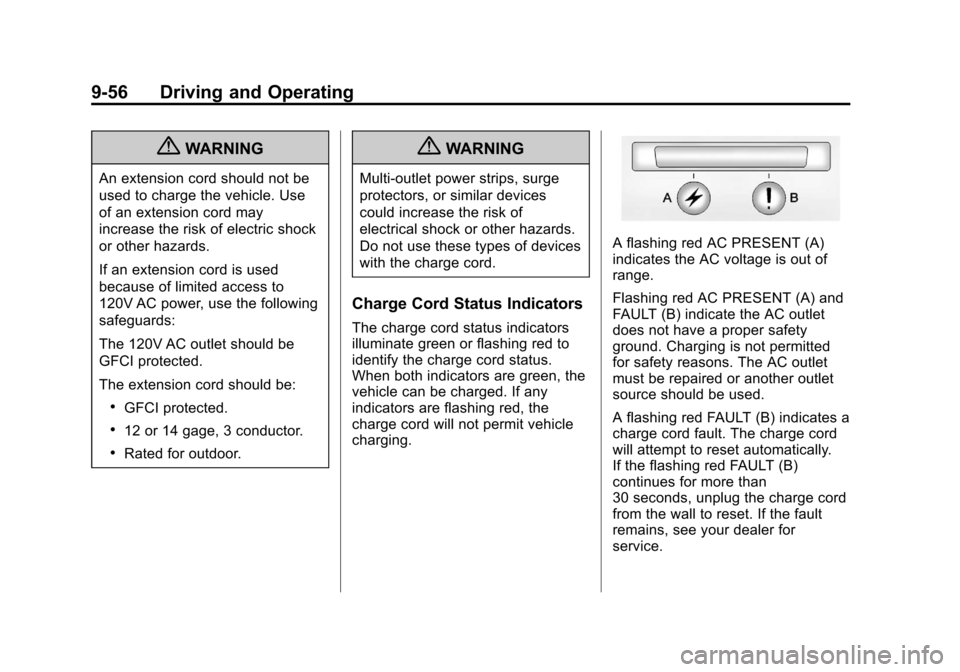
Black plate (56,1)Chevrolet Volt Owner Manual - 2012
9-56 Driving and Operating
{WARNING
An extension cord should not be
used to charge the vehicle. Use
of an extension cord may
increase the risk of electric shock
or other hazards.
If an extension cord is used
because of limited access to
120V AC power, use the following
safeguards:
The 120V AC outlet should be
GFCI protected.
The extension cord should be:
.GFCI protected.
.12 or 14 gage, 3 conductor.
.Rated for outdoor.
{WARNING
Multi‐outlet power strips, surge
protectors, or similar devices
could increase the risk of
electrical shock or other hazards.
Do not use these types of devices
with the charge cord.
Charge Cord Status Indicators
The charge cord status indicators
illuminate green or flashing red to
identify the charge cord status.
When both indicators are green, the
vehicle can be charged. If any
indicators are flashing red, the
charge cord will not permit vehicle
charging.
A flashing red AC PRESENT (A)
indicates the AC voltage is out of
range.
Flashing red AC PRESENT (A) and
FAULT (B) indicate the AC outlet
does not have a proper safety
ground. Charging is not permitted
for safety reasons. The AC outlet
must be repaired or another outlet
source should be used.
A flashing red FAULT (B) indicates a
charge cord fault. The charge cord
will attempt to reset automatically.
If the flashing red FAULT (B)
continues for more than
30 seconds, unplug the charge cord
from the wall to reset. If the fault
remains, see your dealer for
service.
Page 295 of 454
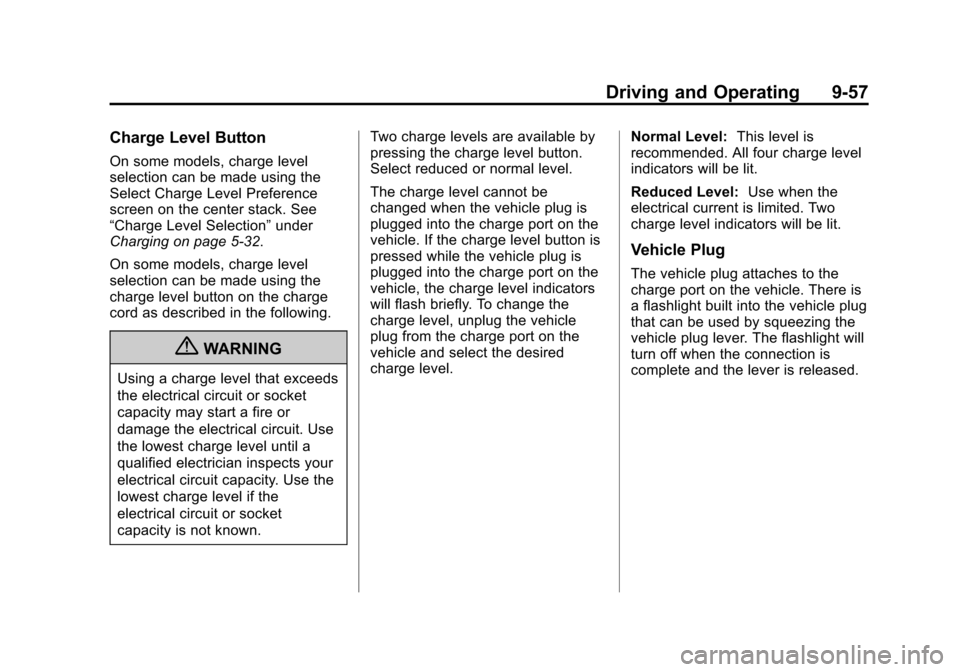
Black plate (57,1)Chevrolet Volt Owner Manual - 2012
Driving and Operating 9-57
Charge Level Button
On some models, charge level
selection can be made using the
Select Charge Level Preference
screen on the center stack. See
“Charge Level Selection”under
Charging on page 5‑32.
On some models, charge level
selection can be made using the
charge level button on the charge
cord as described in the following.
{WARNING
Using a charge level that exceeds
the electrical circuit or socket
capacity may start a fire or
damage the electrical circuit. Use
the lowest charge level until a
qualified electrician inspects your
electrical circuit capacity. Use the
lowest charge level if the
electrical circuit or socket
capacity is not known. Two charge levels are available by
pressing the charge level button.
Select reduced or normal level.
The charge level cannot be
changed when the vehicle plug is
plugged into the charge port on the
vehicle. If the charge level button is
pressed while the vehicle plug is
plugged into the charge port on the
vehicle, the charge level indicators
will flash briefly. To change the
charge level, unplug the vehicle
plug from the charge port on the
vehicle and select the desired
charge level.
Normal Level:
This level is
recommended. All four charge level
indicators will be lit.
Reduced Level: Use when the
electrical current is limited. Two
charge level indicators will be lit.
Vehicle Plug
The vehicle plug attaches to the
charge port on the vehicle. There is
a flashlight built into the vehicle plug
that can be used by squeezing the
vehicle plug lever. The flashlight will
turn off when the connection is
complete and the lever is released.
Page 296 of 454
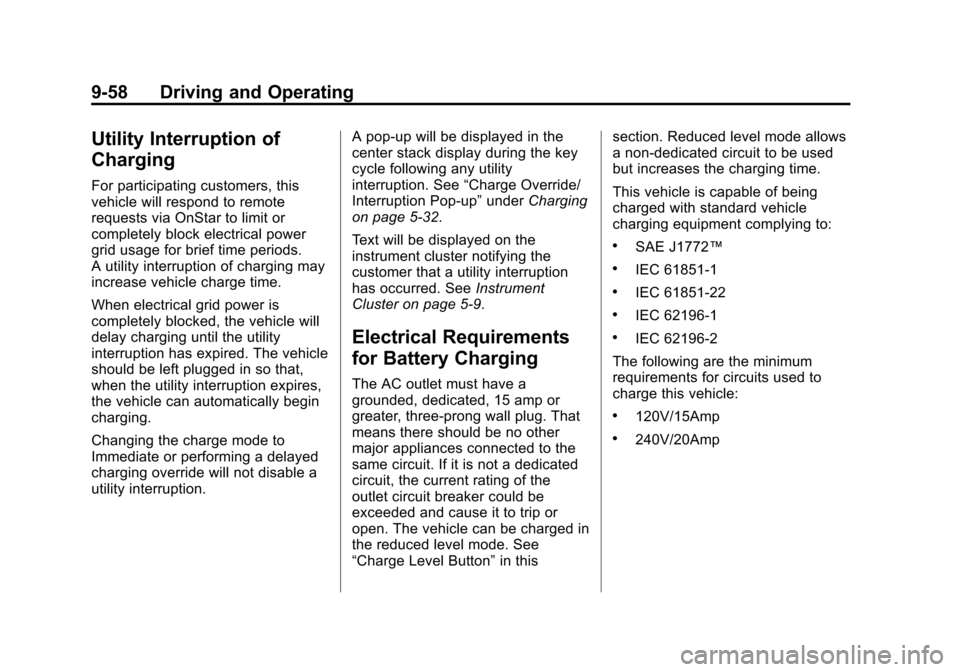
Black plate (58,1)Chevrolet Volt Owner Manual - 2012
9-58 Driving and Operating
Utility Interruption of
Charging
For participating customers, this
vehicle will respond to remote
requests via OnStar to limit or
completely block electrical power
grid usage for brief time periods.
A utility interruption of charging may
increase vehicle charge time.
When electrical grid power is
completely blocked, the vehicle will
delay charging until the utility
interruption has expired. The vehicle
should be left plugged in so that,
when the utility interruption expires,
the vehicle can automatically begin
charging.
Changing the charge mode to
Immediate or performing a delayed
charging override will not disable a
utility interruption.A pop‐up will be displayed in the
center stack display during the key
cycle following any utility
interruption. See
“Charge Override/
Interruption Pop‐up” underCharging
on page 5‑32.
Text will be displayed on the
instrument cluster notifying the
customer that a utility interruption
has occurred. See Instrument
Cluster on page 5‑9.
Electrical Requirements
for Battery Charging
The AC outlet must have a
grounded, dedicated, 15 amp or
greater, three‐prong wall plug. That
means there should be no other
major appliances connected to the
same circuit. If it is not a dedicated
circuit, the current rating of the
outlet circuit breaker could be
exceeded and cause it to trip or
open. The vehicle can be charged in
the reduced level mode. See
“Charge Level Button” in thissection. Reduced level mode allows
a non‐dedicated circuit to be used
but increases the charging time.
This vehicle is capable of being
charged with standard vehicle
charging equipment complying to:
.SAE J1772™
.IEC 61851‐1
.IEC 61851‐22
.IEC 62196‐1
.IEC 62196‐2
The following are the minimum
requirements for circuits used to
charge this vehicle:
.120V/15Amp
.240V/20Amp
Page 297 of 454
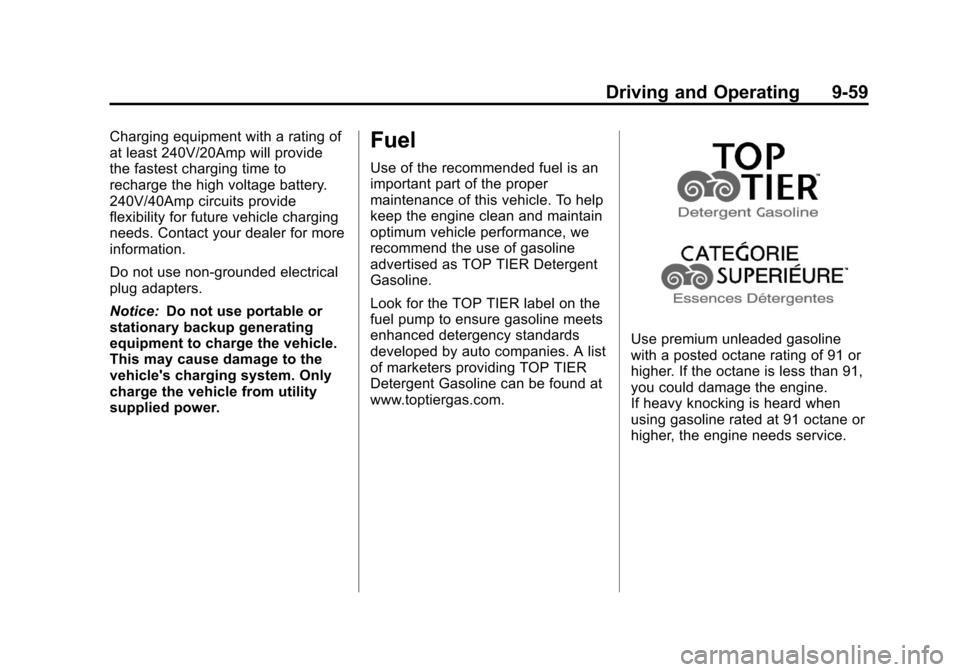
Black plate (59,1)Chevrolet Volt Owner Manual - 2012
Driving and Operating 9-59
Charging equipment with a rating of
at least 240V/20Amp will provide
the fastest charging time to
recharge the high voltage battery.
240V/40Amp circuits provide
flexibility for future vehicle charging
needs. Contact your dealer for more
information.
Do not use non‐grounded electrical
plug adapters.
Notice:Do not use portable or
stationary backup generating
equipment to charge the vehicle.
This may cause damage to the
vehicle's charging system. Only
charge the vehicle from utility
supplied power.Fuel
Use of the recommended fuel is an
important part of the proper
maintenance of this vehicle. To help
keep the engine clean and maintain
optimum vehicle performance, we
recommend the use of gasoline
advertised as TOP TIER Detergent
Gasoline.
Look for the TOP TIER label on the
fuel pump to ensure gasoline meets
enhanced detergency standards
developed by auto companies. A list
of marketers providing TOP TIER
Detergent Gasoline can be found at
www.toptiergas.com.
Use premium unleaded gasoline
with a posted octane rating of 91 or
higher. If the octane is less than 91,
you could damage the engine.
If heavy knocking is heard when
using gasoline rated at 91 octane or
higher, the engine needs service.
Page 298 of 454
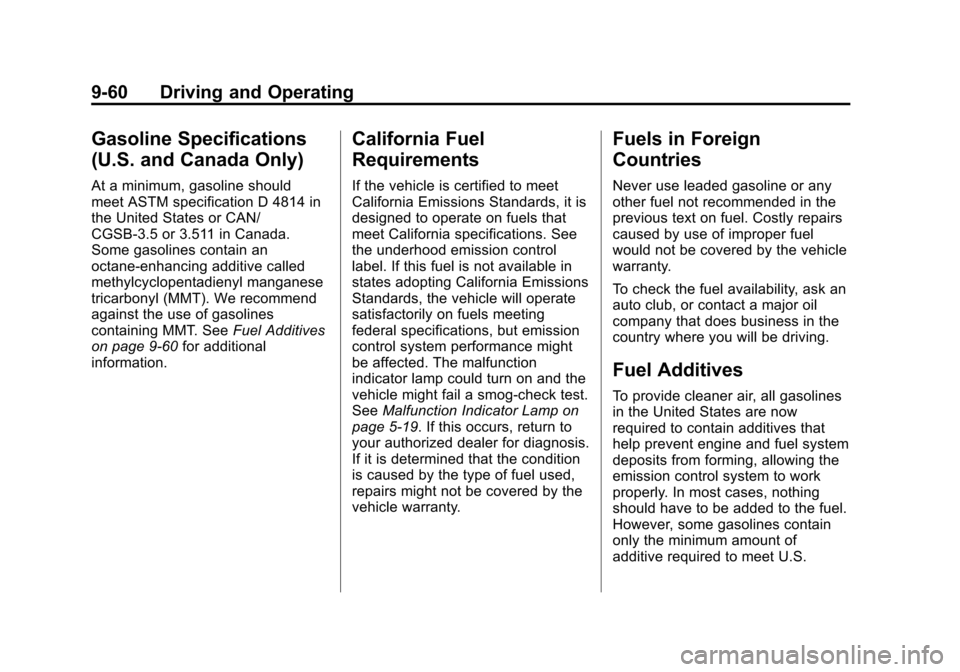
Black plate (60,1)Chevrolet Volt Owner Manual - 2012
9-60 Driving and Operating
Gasoline Specifications
(U.S. and Canada Only)
At a minimum, gasoline should
meet ASTM specification D 4814 in
the United States or CAN/
CGSB‐3.5 or 3.511 in Canada.
Some gasolines contain an
octane-enhancing additive called
methylcyclopentadienyl manganese
tricarbonyl (MMT). We recommend
against the use of gasolines
containing MMT. SeeFuel Additives
on page 9‑60 for additional
information.
California Fuel
Requirements
If the vehicle is certified to meet
California Emissions Standards, it is
designed to operate on fuels that
meet California specifications. See
the underhood emission control
label. If this fuel is not available in
states adopting California Emissions
Standards, the vehicle will operate
satisfactorily on fuels meeting
federal specifications, but emission
control system performance might
be affected. The malfunction
indicator lamp could turn on and the
vehicle might fail a smog‐check test.
See Malfunction Indicator Lamp on
page 5‑19. If this occurs, return to
your authorized dealer for diagnosis.
If it is determined that the condition
is caused by the type of fuel used,
repairs might not be covered by the
vehicle warranty.
Fuels in Foreign
Countries
Never use leaded gasoline or any
other fuel not recommended in the
previous text on fuel. Costly repairs
caused by use of improper fuel
would not be covered by the vehicle
warranty.
To check the fuel availability, ask an
auto club, or contact a major oil
company that does business in the
country where you will be driving.
Fuel Additives
To provide cleaner air, all gasolines
in the United States are now
required to contain additives that
help prevent engine and fuel system
deposits from forming, allowing the
emission control system to work
properly. In most cases, nothing
should have to be added to the fuel.
However, some gasolines contain
only the minimum amount of
additive required to meet U.S.
Page 299 of 454
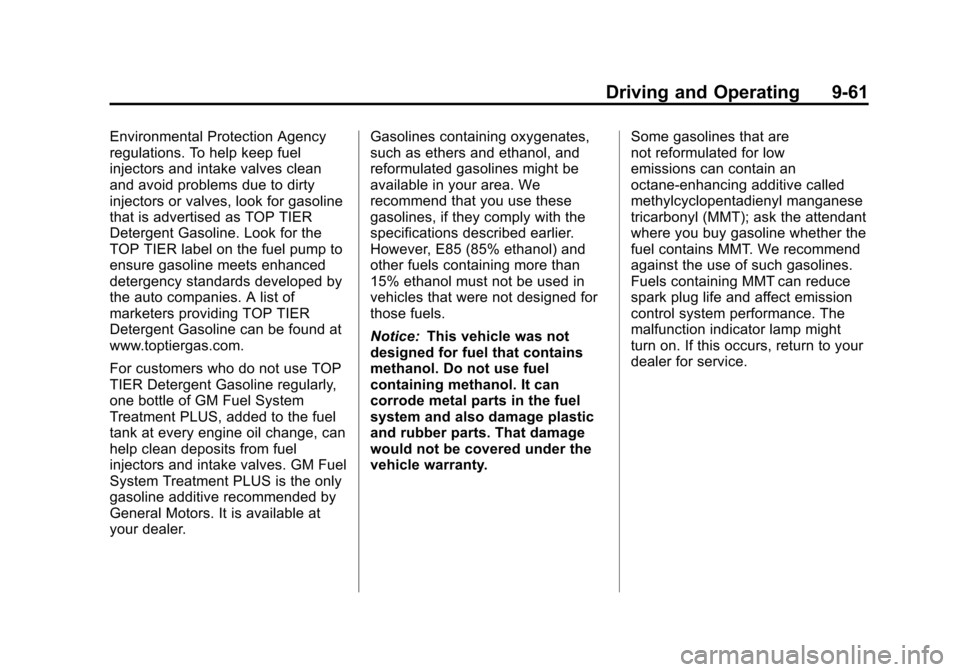
Black plate (61,1)Chevrolet Volt Owner Manual - 2012
Driving and Operating 9-61
Environmental Protection Agency
regulations. To help keep fuel
injectors and intake valves clean
and avoid problems due to dirty
injectors or valves, look for gasoline
that is advertised as TOP TIER
Detergent Gasoline. Look for the
TOP TIER label on the fuel pump to
ensure gasoline meets enhanced
detergency standards developed by
the auto companies. A list of
marketers providing TOP TIER
Detergent Gasoline can be found at
www.toptiergas.com.
For customers who do not use TOP
TIER Detergent Gasoline regularly,
one bottle of GM Fuel System
Treatment PLUS, added to the fuel
tank at every engine oil change, can
help clean deposits from fuel
injectors and intake valves. GM Fuel
System Treatment PLUS is the only
gasoline additive recommended by
General Motors. It is available at
your dealer.Gasolines containing oxygenates,
such as ethers and ethanol, and
reformulated gasolines might be
available in your area. We
recommend that you use these
gasolines, if they comply with the
specifications described earlier.
However, E85 (85% ethanol) and
other fuels containing more than
15% ethanol must not be used in
vehicles that were not designed for
those fuels.
Notice:
This vehicle was not
designed for fuel that contains
methanol. Do not use fuel
containing methanol. It can
corrode metal parts in the fuel
system and also damage plastic
and rubber parts. That damage
would not be covered under the
vehicle warranty. Some gasolines that are
not reformulated for low
emissions can contain an
octane-enhancing additive called
methylcyclopentadienyl manganese
tricarbonyl (MMT); ask the attendant
where you buy gasoline whether the
fuel contains MMT. We recommend
against the use of such gasolines.
Fuels containing MMT can reduce
spark plug life and affect emission
control system performance. The
malfunction indicator lamp might
turn on. If this occurs, return to your
dealer for service.
Page 300 of 454
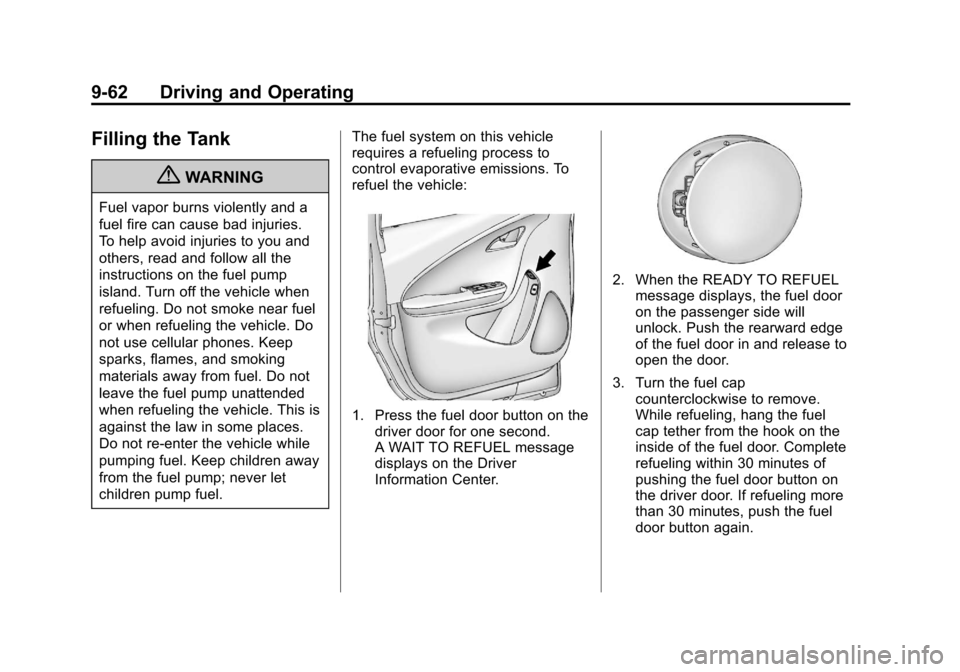
Black plate (62,1)Chevrolet Volt Owner Manual - 2012
9-62 Driving and Operating
Filling the Tank
{WARNING
Fuel vapor burns violently and a
fuel fire can cause bad injuries.
To help avoid injuries to you and
others, read and follow all the
instructions on the fuel pump
island. Turn off the vehicle when
refueling. Do not smoke near fuel
or when refueling the vehicle. Do
not use cellular phones. Keep
sparks, flames, and smoking
materials away from fuel. Do not
leave the fuel pump unattended
when refueling the vehicle. This is
against the law in some places.
Do not re-enter the vehicle while
pumping fuel. Keep children away
from the fuel pump; never let
children pump fuel.The fuel system on this vehicle
requires a refueling process to
control evaporative emissions. To
refuel the vehicle:
1. Press the fuel door button on the
driver door for one second.
A WAIT TO REFUEL message
displays on the Driver
Information Center.
2. When the READY TO REFUELmessage displays, the fuel door
on the passenger side will
unlock. Push the rearward edge
of the fuel door in and release to
open the door.
3. Turn the fuel cap counterclockwise to remove.
While refueling, hang the fuel
cap tether from the hook on the
inside of the fuel door. Complete
refueling within 30 minutes of
pushing the fuel door button on
the driver door. If refueling more
than 30 minutes, push the fuel
door button again.